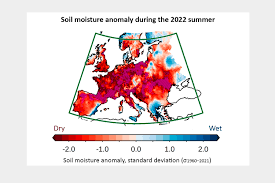The Summer 2022 Drought: How Climate Change Made It Worse Than Ever

The summer of 2022 brought one of the worst droughts Europe has seen in decades, leaving the soil parched and dry across much of the continent. As the relentless heat stretched from June through August, public discussions inevitably turned to the role climate change played in amplifying this extreme event. Now, a study led by the Helmholtz Centre for Environmental Research (UFZ) reveals that over 30% of the drought's severity can be directly linked to human-caused climate change. According to their findings published in Nature Geoscience, this wasn’t just an isolated summer struggle—years of climate-driven soil drying set the stage for what became an extraordinary crisis.
How the Drought Unfolded
The drought’s impact wasn’t just felt in the natural landscape—it disrupted daily life across Central and Southern Europe. In Italy, half the population faced water restrictions, and in France, more than 100 towns had to truck in drinking water. Agriculture took a hard hit, with crops like grain maize, sunflower, and soybean seeing a 15% drop in yields compared to the previous five-year average. The dry conditions also fueled severe wildfires in countries like Italy, France, Slovenia, and Romania. On the rivers, navigation came to a near standstill as levels in major waterways like the Po and Rhine dropped, hampering shipping and even hydroelectric power generation.
"The drought in 2022 didn’t just cause environmental harm—it led to serious socio-economic consequences for Europe," explains Dr. Emanuele Bevacqua, the lead author of the study and head of the UFZ's Compound Climate Extremes group.
Untangling the Role of Climate Change
It’s long been understood that human activity is altering our climate, but precisely quantifying the extent to which climate change drives specific events like droughts has been tricky. The research team tackled this challenge by analyzing soil moisture levels across Europe, using the mHM hydrological model developed at UFZ to account for precipitation and temperature data. Their findings paint a stark picture: from June to August, Central and Southern Europe saw soil moisture deficits amounting to 280 cubic kilometers—roughly the same as draining 120 million Olympic-sized swimming pools.
Furthermore, nearly 1.64 million square kilometers, or 29% of the land area in these regions, were affected by drought—the largest expanse since records began in 1960. "Our simulations show that the 2022 drought was the most extreme since the start of our measurements," Bevacqua adds. It wasn’t just the lack of rainfall that caused trouble; unusually high temperatures also played a significant part. The summer’s average temperature in Central and Southern Europe was 1.9°C above the 1981-2010 average, leading to increased evaporation rates and even lower soil moisture.
How Much Was Climate Change to Blame?
To pinpoint climate change’s contribution to the 2022 drought, the researchers compared two scenarios: one using actual weather data, and another excluding the effects of climate change on temperature and precipitation. Their calculations revealed that roughly 31% of the soil moisture deficit, amounting to 87 cubic kilometers, was due to climate change. Similarly, climate change accounted for 38% of the drought-affected area, translating to an additional 0.61 million square kilometers impacted. "Higher temperatures, driven by climate change, ramped up evaporation and made the soil dry out faster," explains Prof. Dr. Jakob Zscheischler, co-author and head of the UFZ’s Department of Compound Environmental Risks.
This intensifying effect extended beyond the ground; climate change also affected the flow of Europe’s rivers, which worsened navigational challenges and decreased hydroelectric power production. According to the team’s findings, about 19% of the area where rivers ran dry could be attributed to climate-driven changes.
The Hidden, Long-Term Effects
One key insight from the study is that the impact of climate change on droughts isn’t always immediate. "Rising temperatures don’t just hit suddenly; their effects build up over time," explains Zscheischler. He points out that soil moisture and water levels were already below normal as the 2021/2022 water management year kicked off in November 2021—a situation unlikely to have happened without human-induced climate change.
The researchers quantified how this long-term warming trend contributed to the severity of the 2022 drought. They found that delayed effects accounted for 14-41% of the total climate change influence, depending on the specific model used. This suggests that the groundwork for the drought’s intensity was laid well before the summer heatwave hit. "Climate change has steadily increased temperatures and dried out the soil in recent years, setting up conditions for the extreme drought in 2022," Zscheischler explains.
Why This Matters
Understanding the delayed effects of climate change on droughts is crucial because water needs in Europe largely depend on groundwater, which is already over-exploited in many regions. This is a growing concern as climate change continues to reduce soil moisture and river flows, directly impacting agriculture, energy production, and public water supply. As Emanuele Bevacqua emphasizes, "We’ve only just begun to fully grasp the long-term role climate change plays in droughts."
Story Source:
Materials provided by Helmholtz Centre for Environmental Research - UFZ. The original text of this story is licensed under a Creative Commons License. Note: Content may be edited for style and length.
Journal Reference:
- Emanuele Bevacqua, Oldrich Rakovec, Dominik L. Schumacher, Rohini Kumar, Stephan Thober, Luis Samaniego, Sonia I. Seneviratne, Jakob Zscheischler. Direct and lagged climate change effects intensified the 2022 European drought. Nature Geoscience, 2024; DOI: 10.1038/s41561-024-01559-2
0 Comments